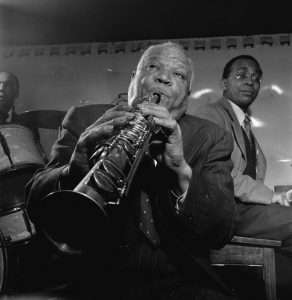
Sidney Bechet was a unique figure in jazz history. A masterful soprano-saxophonist and clarinetist, he recorded the first significant jazz solos (other than pianists). Bechet, whose fiery personality was sometimes a liability, was a dominant player who preferred that the trumpeter in his bands state a simple melodic lead so he could create virtuosic counter-melodies around him.
If the trumpeter failed in the task or tried to challenge him, Bechet could easily wipe him out with his powerful tone which had a wide but perfectly-controlled vibrato. He was not going to play second fiddle to a mere trumpeter! All of the musicians in his groups ended up being in the supporting cast anyway, supporting the brilliant Bechet.
Growing up in New Orleans
He was born May 14, 1897 in New Orleans. Growing up surrounded by music (his older brother Leonard played trombone), Sidney tried out a variety of instruments as a toddler, settling on the clarinet. At the age of six, he was already strong enough to perform with his brother’s group (the Silver Bells Band) at a party.
At eight, he sat in with cornetist Freddie Keppard’s band, faring quite well and quickly gaining a strong reputation in the Crescent City. He took a few lessons from a trio of clarinetists (Lorenzo Tio, Big Eye Louis Nelson, and George Baquet), soon surpassing each of them even if he never learned to read music.
By the time he was 15, he had worked with Keppard, Buddie Petit’s Young Olympians (1909), John Robichaux (1911-12), Bunk Johnson in The Eagle Band and next to King Oliver in The Olympic Band. Considered the top clarinetist in New Orleans, Bechet also doubled on cornet during the era (though unfortunately he never recorded on it) and he gave clarinet lessons to Jimmie Noone who was actually two years older.
Set to Traveling
Sidney Bechet always looked back with pride at his New Orleans years, but by 1914 he had the itch to explore a larger world. He began working with traveling shows and carnivals, traveling throughout the South. In 1917 he arrived in Chicago where he took jobs with transplanted New Orleanians King Oliver, Freddie Keppard and clarinetist Lawrence Duhe. By the spring of 1919, Bechet was in New York where he joined Will Marion Cook’s Southern Syncopated Orchestra for their groundbreaking tour of Europe.
The Original Dixieland Jazz Band had recently introduced jazz to London, causing a sensation. Although it was more of a show band with large productions, Will Marion Cook’s 27-piece orchestra enjoyed a similar success performing at London’s Royal Philharmonic Hall for five months. Bechet was showcased on a clarinet feature during “Characteristic Blues” that consistently brought down the house.
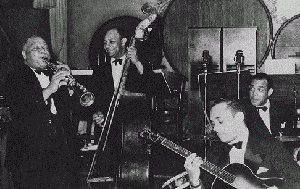
The Swiss classical conductor Ernest Arnsermet wrote a very perceptive review of Bechet’s playing in the October 1919 issue of Revue Romande. Ansermet raved about Bechet’s originality and predicted that there was a good chance that the music world of the future would be following in his footsteps.
Sidney Bechet had a particularly colorful life in the 1920s. A dispute over wages resulted in him being among several musicians that left Will Marion Cook later in 1919. At that time he bought his first soprano saxophone. Bechet would double between soprano and clarinet throughout the rest of his life, with the louder and more forceful soprano becoming his main instrument.
For the next three years, Bechet mostly played in London with a combo led by drummer Benny Payton, also sometimes visiting France. With Peyton he made his first recording (“High Society” and “Tiger Rag”) in early 1920, but it was never issued. In Sept. 1922, shortly after putting together his own group, Bechet was arrested and charged with assaulting a woman who was probably a prostitute. He spent two weeks in jail and was deported back to the U.S.
Early Recordings
Soon Bechet was acting as a saxophone-playing Chinese laundryman (!) in How Come, a traveling show that prominently featured Bessie Smith. Bechet recorded “Sister Kate” in January 1923 on what would have been Smith’s first record but that too went unreleased.
He spent part of the year back with Will Marion Cook in an American vaudeville production, but more importantly, he began to record regularly. On July 30, 1923 on his first released recordings, Bechet was in the spotlight throughout “Wild Cat Blues” and “Kansas City Man Blues,” taking innovative solos.
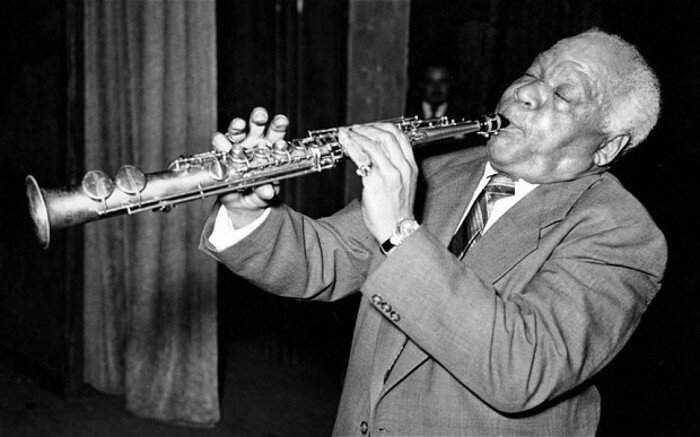 A master at playing blues, Bechet was utilized on a variety of sessions organized by pianist Clarence Williams including with blues singers Sara Martin, Mamie Smith, Rosetta Crawford, Margaret Johnson, Virginia Liston, Sippie Wallace, and Alberta Hunter. He uplifted swinging numbers featuring Williams’ wife Eva Taylor and starred, often next to Louis Armstrong, with Clarence Williams’ Blue Five and the Red Onion Jazz Babies.
A master at playing blues, Bechet was utilized on a variety of sessions organized by pianist Clarence Williams including with blues singers Sara Martin, Mamie Smith, Rosetta Crawford, Margaret Johnson, Virginia Liston, Sippie Wallace, and Alberta Hunter. He uplifted swinging numbers featuring Williams’ wife Eva Taylor and starred, often next to Louis Armstrong, with Clarence Williams’ Blue Five and the Red Onion Jazz Babies.
The competitive playing of Armstrong and Bechet made musical history. While Armstrong took honors on an uptempo “Cake Walking Babies From Home,” Bechet could not be topped on “Mandy, Make Up Your Mind” which has his only recording on the bass sarrusophone!
The 20’s
In 1924 Bechet worked with the Black And White Revue, James P. Johnson, Willie “The Lion” Smith and several months with Duke Ellington’s Washingtonians. Although he never recorded with Ellington, the two were lifelong mutual admirers. Bechet became the early mentor for altoist Johnny Hodges (who occasionally doubled on soprano until 1940) when both worked with James P. Johnson.
After having an unsuccessful period running his own Club Basha in New York, Bechet was ready to roam again. He went to France in Sept. 1925 with La Revue Nègre, the show that made Josephine Baker into a star. During the next few years, Bechet traveled and performed all over Europe including in Paris, Berlin and even Russia. However a shooting incident with banjoist Mike McKendrick resulted in him being jailed in Paris for 11 months during 1928-29. Deported after his release, he spent time playing in Berlin, appeared in a film, and in late 1930 headed back to New York.
The 30’s
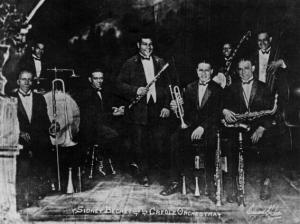
Sidney Bechet worked on and off with Noble Sissle’s show band during 1931-37. While he always had a few features and was happy to be back on records again (having not recorded during 1926-30), the music was not that satisfying. Bechet departed and led the New Orleans Feetwarmers during part of 1932.
The band, which also featured trumpeter Tommy Ladnier, recorded a very exciting session that was highlighted by uptempo romps on ‘I’ve Found A New Baby,” “Shag” and “Maple Leaf Rag.” But the group did not last more than a few months. The Depression was at its height, and Bechet took a temporary detour.
He operated the Southern Tailor Shop with Ladnier in New York. But because they spent more time having jam sessions in the back room than they did working on tailoring, that venture soon closed. Bechet returned to Noble Sissle’s orchestra (1934-38), having a low profile in a jazz world that was filled with big bands and swing.
Revival
In 1938 a greater interest in early jazz performers resulted in Bechet appearing on records by singers Trixie Smith and Leola Wilson. He soon led his first record date in six years, was the star of Mezz Mezzrow’s “Really The Blues” session, and reunited with Ladnier in a new version of the New Orleans Feetwarmers that appeared at John Hammond’s Spirituals To Swing concert at Carnegie Hall. 1939 included a hit version of “Summertime” for the Blue Note label, and a memorable record date with Jelly Roll Morton.
Signed to the Victor label, Bechet made many of his most famous recordings during 1940-41 including “Old Man Blues,” “Nobody Knows The Way I Feel This Morning,” the haunting “Egyptian Fantasy,” and “I Know That You Know.” He also recorded two classic matchups with cornetist Muggsy Spanier in a pianoless drumless quartet with guitar and bass, had a reunion with Louis Armstrong in 1940 that resulted in competitive recordings of four songs, and he made his famous “One-Man Band” session of Apr. 19, 1941.
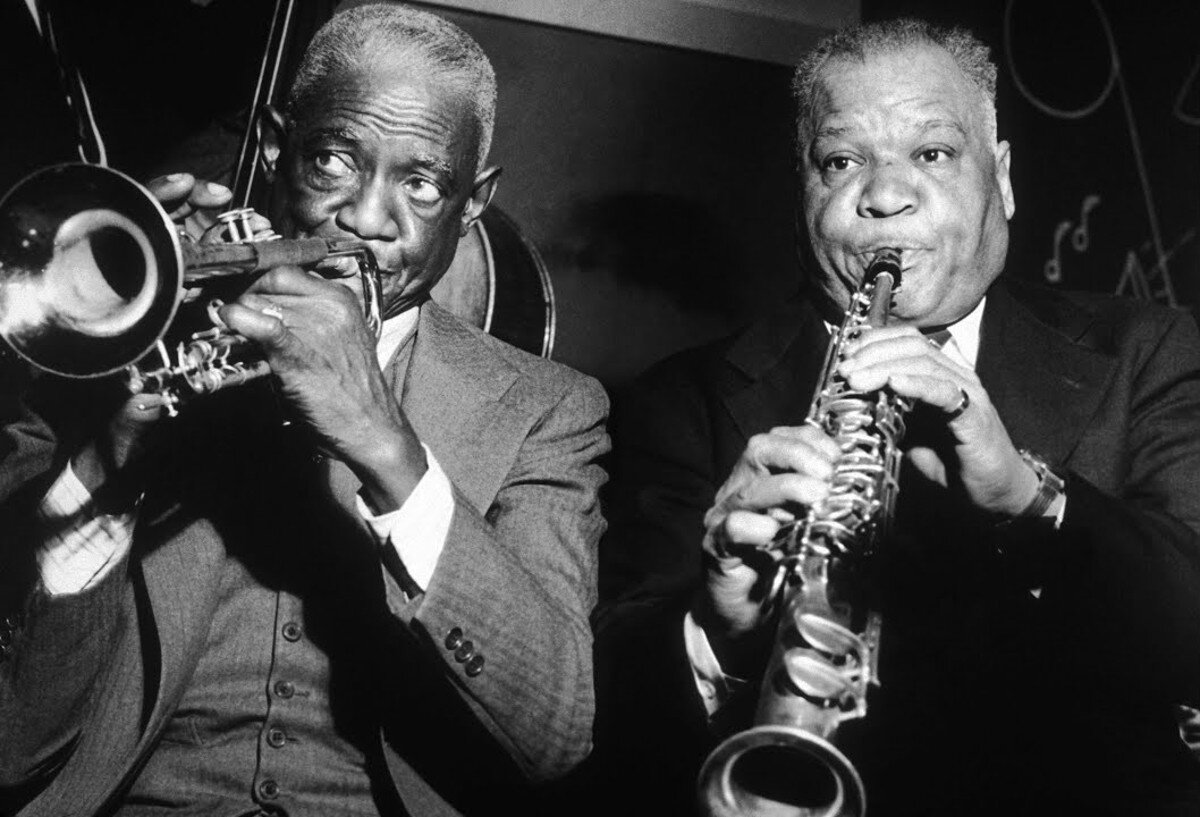
On the latter, Bechet played clarinet, soprano, tenor, piano, bass and drums via overdubbing (a revolutionary idea at the time), resulting in unusual versions of “The Sheik Of Araby” and “Blues Of Bechet.” After the Victor contract ended, Bechet recorded many worthy sessions for Mezz Mezzrow’s King Jazz label and for Blue Note including a set in 1945 with Bunk Johnson.
With the New Orleans revival movement in full swing, Bechet worked steadily during the first half of the 1940s including making appearances on a few of Eddie Condon’s famed Town Hall radio broadcasts. While he was perfectly comfortable playing swing tunes like “One O’Clock Jump” and Duke Ellington’s “Stompy Jones,” it was Bechet’s goal to perform an old-time New Orleans band like the ones from his childhood. He persuaded Bunk Johnson to join his new band but Bunk’s excessive drinking and erratic playing resulted in the group not lasting more than a few months.
Things began to slow down by 1948 with the rise of bebop and rhythm and blues. Bechet continued working while also thinking about becoming a music teacher. He put up a sign at his home but only attracted one student, Bob Wilber, who became his protégé. Bechet began to become restless again.
Paris
In May 1949, Sidney Bechet returned to Paris to perform at the International Jazz Festival, where he was one of the main hits along with Charlie Parker. Bechet so enjoyed the adulation of the crowd that within a year he had permanently settled in France. While few in the United States outside of the jazz fans knew who Bechet was, in France he became a household name. Large audiences were attracted to his music, his enthusiastic playing and his brilliance. He was considered a national hero and a celebrity.
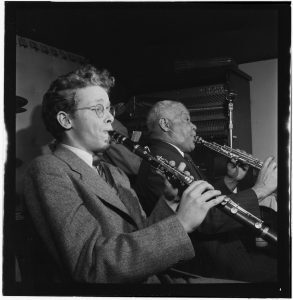
In France during most of his final decade, Bechet performed the New Orleans jazz standards, Dixieland tunes and ballads that he most enjoyed. He never lost his enthusiasm for the music or his ability to come up with creative and surprising ideas.
Still very much in his musical prime, he used young French players (often from either clarinetist Andre Reweliotty or Claude Luter’s band) who were in awe of him and did not mind him completely dominating the music. While he mostly performed on the European continent, there were occasional reunions with touring Americans (including a very exciting session with trumpeter Jonah Jones) and Bechet made a few visits to the U.S. until 1953.
Recording mostly for Vogue during his last period, he had hit records with “Les Oignons” and “Petite Fleur,” and showed on a quartet project in 1957 with modern jazz pianist Martial Solal that he was quite capable of playing sophisticated tunes. He appeared in several French movies and, despite not knowing how to read music, composed a classical ballet (La Nuit est sorciere). In 1958 he completed his memorable and poetic autobiography Treat It Gentle.
Bechet’s last hurrah was at the Brussels World’s Fair in 1958 where he led an American group featuring Buck Clayton and Vic Dickenson. Soon afterwards, he was stricken with lung cancer. His final recordings (from Dec. 12, 1958) are of spirited versions of four Christmas-related songs and a remake of “Les Oignons.” He passed away on his 62nd birthday, May 14, 1959.
Sidney Bechet was such a dominant force on the soprano-sax that for many years hardly anyone else in jazz played that instrument. He ranks with Louis Armstrong as the most technically skilled and gifted of all New Orleans musicians.
Also See:
Sidney Bechet (1897-1959)
The New Orleans Feetwarmers
King Bechet Trio
Sidney Bechet and his Orchestra
Since 1975 Scott Yanow has been a regular reviewer of albums in many jazz styles. He has written for many jazz and arts magazines, including JazzTimes, Jazziz, Down Beat, Cadence, CODA, and the Los Angeles Jazz Scene, and was the jazz editor for Record Review. He has written an in-depth biography on Dizzy Gillespie for AllMusic.com. He has authored 11 books on jazz, over 900 liner notes for CDs and over 20,000 reviews of jazz recordings.
Yanow was a contributor to and co-editor of the third edition of the All Music Guide to Jazz. He continues to write for Downbeat, Jazziz, the Los Angeles Jazz Scene, the Jazz Rag, the New York City Jazz Record and other publications.























